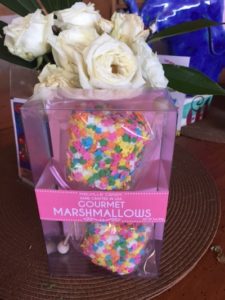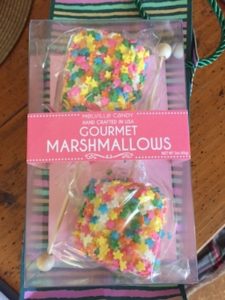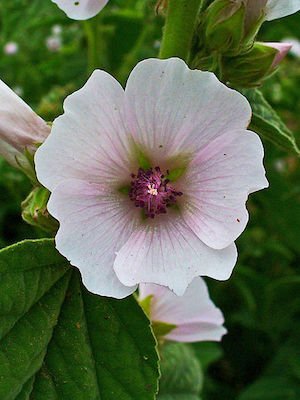New Historic American (and Jewish) Marshmallow Easter Treats
 (Gerry Furth-Sides) For lovers of food with texture, such as myself, marshmallow confections such as Peeps have always been a favorite. This year my list of treats now also includes the new Melville Candy Company marshmallow lollipops.
(Gerry Furth-Sides) For lovers of food with texture, such as myself, marshmallow confections such as Peeps have always been a favorite. This year my list of treats now also includes the new Melville Candy Company marshmallow lollipops.

 Melville Candy Company is a family owned, third generation confectionery company located in Weymouth, Massachusetts. Using a family recipe perfected by Grandpa Melville over 75 years ago, the company produces gourmet hard candy lollipops and chocolate treats.
Melville Candy Company is a family owned, third generation confectionery company located in Weymouth, Massachusetts. Using a family recipe perfected by Grandpa Melville over 75 years ago, the company produces gourmet hard candy lollipops and chocolate treats.

Master candy maker Grandpa Francis E. Melville
Opened in 1978 by father and son duo, Gary and Joe Melville, the family proudly continues the Melville family tradition of creating custom confections that fulfill the promise of “delighting the masses.”

Each product produced is hand-made, packed and inspected in the USA to ensure they are of the highest quality. Their extensive selection includes Gourmet Flavor Lollipops embedded with a variety of specialty ingredients, Honey Spoons made with real honey in each batch, and seasonal & trendy collections.
Master candy maker Grandpa Francis E. Melville devoted his entire life to embodying the values of family, hard work, loyalty, respect, and achieving the very best quality candy, according to family history. The children note on their website that “his values have remained at the base of the business. ”
 Adding to this sweet story is the history of PEEPS, the lovable confection that turns out to have a novel “Jewish” history. Here is an article on the story from the JEWISH FORWARD.
Adding to this sweet story is the history of PEEPS, the lovable confection that turns out to have a novel “Jewish” history. Here is an article on the story from the JEWISH FORWARD.
The history of the marshmallow is as intriguing as its spongy texture, which is corn starch coated for that silky feeling.

The word “marshmallow” stems from the mallow plant, Althaea officinalis, which grows in marshes and is native to certain areas of Europe, North Africa, and Asia. The plant (shown above) has a fleshy stem, leaves, and a five-petaled white flower.
Marshmallow history is not exact but does date back to 2000 BC, where privileged Egyptians in ancient Egypt were described as eating them. There it was strictly reserved for gods and royalty, who took the root of the plant and used it as a medicinal to sooth coughs and sore throats and heal wounds.
The first marshmallows were prepared by boiling pieces of root pulp with sugar until it thickened. Once thickened, the mixture was strained and cooled.
By the early to mid-1800’s, the marshmallow had made its way to France where confectioners united the plant’s medicinal purposes with indulgent ingredients utilized by the Egyptians.
Whether used for candy or medicinal purposes, the manufacturing process was limited to a small scale because it was so labor intensive. Small candy store owners would whip the sap from the mallow root into a fluffy candy using sugar, water, and egg whites.
This candy was called Pâté de Guimauve. The spongy-soft dessert made from whipping dried marshmallow roots with sugar, water, and egg whites was still considered medicinal. It was sold in bar form as a lozenge.
Small shop Confectioners in early 19th century France pioneered the innovation of whipping up the marshmallow sap and sweetening it, to make a confection similar to modern marshmallow. After the advance of the two-day marshmallow drying system became more streamlined in the late 1800’s with a starch mogul system, production method improvement came more rapidly.
By the early 20th century, and the popular marshmallows were ready for mass consumption. Penny candies, food recipes were sold in tins as penny candy, and began to be seen in a number of food recipes, such as tutti frutti.
In the United States, the United Kingdom, North America, New Zealand and Australia, roasting or toasting of marshmallows over an open flame, preferably outdoor, became enormously popular. Done properly, this produces a caramelized outer skin with a liquid, molten layer underneath.
In 1948, Greek-American confectioner, Alex Doumak, revolutionized the manufacturing process with an extrusion process involving tubes. And by mid-century, automated systems made it possible to produce thousands of pounds of marshmallow a day.
Still, today, the marshmallow consists of the same four components: sugar, water, air, and a whipping agent (usually a protein) through each brand of has its own specific formula for how to produce the ‘perfect’ marshmallow. While far behind in chocolate consumption, it remains a very special (and low-calorie, healthy) treat all over the world.

 Gerry Furth-Sides
Gerry Furth-Sides  Barbara Hansen
Barbara Hansen  Chef-owner Alain Cohen
Chef-owner Alain Cohen  Roberta Deen
Roberta Deen  Jose Martinez
Jose Martinez  Nivedita Basu
Nivedita Basu